What Is IoT? All You Need to Know About the Internet of Things
The Internet of Things surrounds us in our day-to-day lives. However, not many are aware of the history, the importance, the functionality and the benefits of IoT. Continue reading to learn all about it.
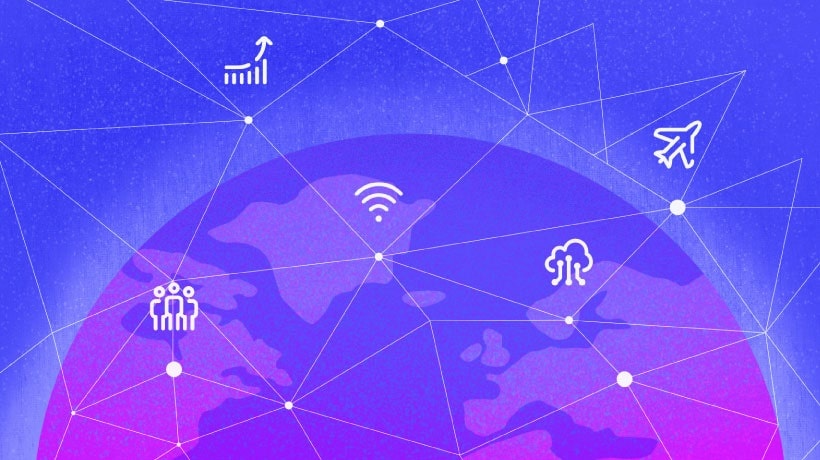
The Internet of Things (IoT) is a term that describes a network of physical objects connected to the internet. These objects, or things, include all kinds of internet-connected devices fitted with IoT sensors, microchips and software.
IoT devices could be anything from small wearable gadgets to large-scale industrial machinery.
The applications of the Internet of Things are almost without limit. Doctors could use IoT to track the health of their patients. Farmers could monitor crops and animals. Businesses could control complex processes. And consumers could get alerts when they’re running low on bread.
With the help of this article, you’ll learn about the history of the Internet of Things, as well as its applications in the real world. You’ll also learn how IoT systems intersect with machine learning, data processing, critical infrastructure and innovative smart cities projects.
The history of IoT
While smart objects and smart cities might be new concepts to many consumers, the idea behind them has been around for a while. Like most cutting-edge technology, computer scientists have been theorizing the Internet of Things for at least the last few decades.
Kevin Ashton, a tech pioneer, came up with the term Internet of Things back in 1999. However, the ideas behind it had been floating around for many years before that.
Electrical and electronics engineers attempted adding microchips to everyday devices back in the 1980s. Despite giving us the first internet-connected vending machines, these early projects were held back by unsophisticated technology and a lack of demand.
For the Internet of Things to take off, it would require smaller, cheaper, more reliable technology and widespread internet adoption.
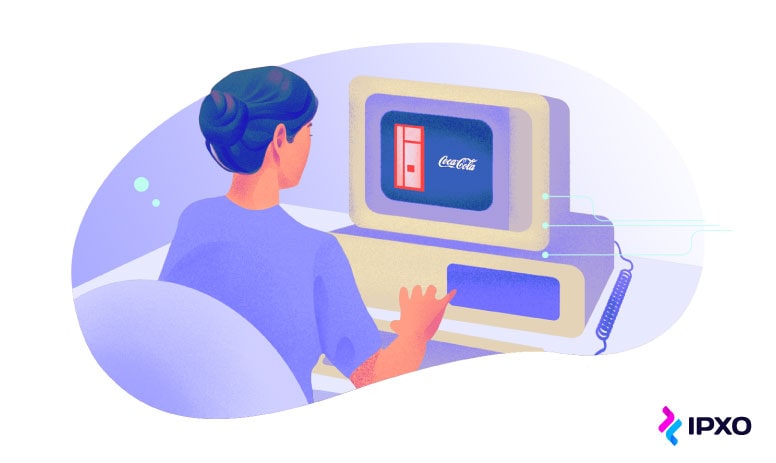
IPv6 changes the world of IoT
The creation of low-cost, low-power radio-frequency identification (RFID) chips, as well as the growing broadband and mobile internet coverage, helped push the dream of connected devices towards reality. However, the big shift came with the introduction of IPv6 (Internet Protocol version 6).
Every IoT device needs a unique Internet Protocol address. Under IPv4 (IP version 4), the world is limited to only 4.29 billion possible IP addresses. That allows for less than one connected device per person on the Earth. And as IPs are hard to come by these days, IoT-based businesses choose IP leasing.
With IPv6, first introduced in 1995, around 3.4×1038 unique IP addresses (i.e., 340 undecillion) became available. Needless to say, that’s enough IP addresses for all smart devices we’ll need in the foreseeable future. This includes both consumer IoT devices as well as industrial devices (industrial IoT). That said, IPv6 adoption is slow, and we still rely heavily on IPv4.
At first, RFID tags were used to track expensive equipment and were largely used exclusively in industrial manufacturing settings. However, as the cost of the technology fell, the once industrial IoT was increasingly introduced to consumer products.
Paired with progressively sophisticated and affordable sensors and other technologies, IoT applications infiltrated the average home. From simple location tags for tracking lost keys to smart fridges that tell you when and what to buy, IoT technology has gone mainstream.
In September 2021, IoT Analytics reported 12.3 billion IoT devices worldwide, and this number could rise to 27 billion by 2025.
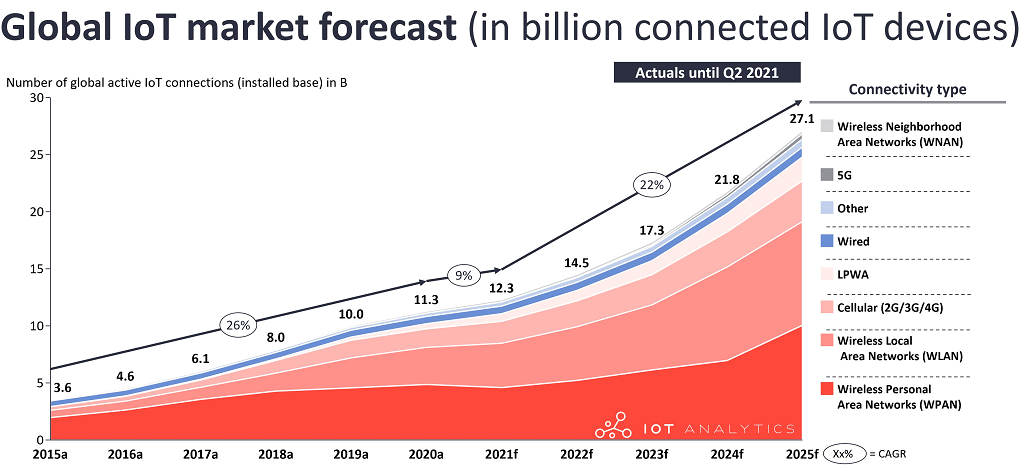
Why is the internet of things important?
The word you come across most often when discussing the adoption of IoT devices is seamless.
The whole idea is that everything like our cars, kitchen appliances, home heating or cooling systems and other IoT devices can collect data and use it to make our lives seamless. The Internet of Things enables easier communication between people, smart devices and the processes that govern our lives.
When you connect devices to the Internet of Things, they sit at the center point of big data, cloud computing, low-cost hardware and sophisticated analytics. With minimum human input, electronic devices connected to the Internet of Things monitor their use and condition, collect data, adjust their settings, automate processes and function more autonomously.
This can save businesses money by automating manufacturing and supply chains. It can improve health outcomes by collecting useful, real-time IoT data about our bodies. It can make our everyday lives less stressful by eliminating time-consuming tasks.
How does IoT work?
As discussed above, IoT networks collect and share data about specific environments and processes. This data can then help take action.
The steps of this process look something like this:
- Data collection: An IoT device gathers information from the physical world around it. It could be a camera, sensor, antenna, microcontroller or some other device.
- Data transfer: The collected data is transferred via an IoT gateway either to the cloud for analysis elsewhere or to a local IoT data processing unit.
- Data analysis: The collected data is processed to uncover patterns and problems.
- Action: Based on the analysis of the IoT data, the original device or other devices in the network can be instructed to take action.
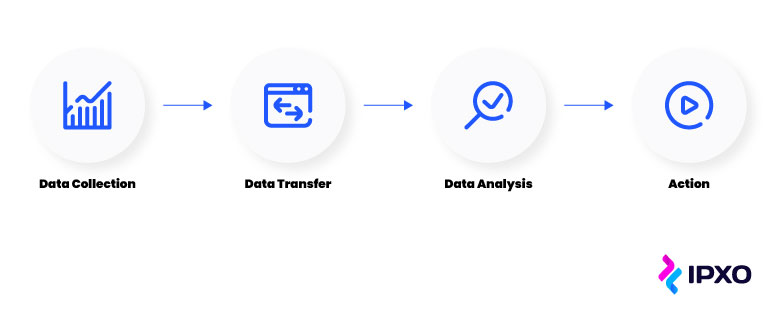
In most cases, the IoT system and connected devices do all this without human intervention. Of course, humans create the settings and rules the IoT devices run by, but most functions are autonomous.
Artificial intelligence and machine learning is a major aspect of IoT development. It allows machines to be increasingly independent of human input.
IoT devices
Now you have a good idea of how an overall IoT ecosystem works. Let’s look at a specific example of how IoT sensor data is fed to the cloud and put to use.
An easy example of an IoT device you’ve likely seen in the real world – and perhaps own yourself – is a smartwatch. Like many IoT devices, it represents the evolution of an existing technology – wristwatches.
However, with the addition of various sensors, gyroscopes and, of course, wireless connectivity, the humble watch has become a smart IoT device. A smartwatch is capable of monitoring steps, heartbeats, sleep activity, location and calories burned. And, of course, time too.
The data collected by all those sensors can then be fed into the cloud and accessed on a laptop, smartphone or tablet. The IoT platform readily processes the raw data into usable graphs and insights.
All this allows the wearer (and perhaps their doctor or fitness trainer) to get a datafied view of their activity and fitness. This data can then inform future behavior and form healthier habits.
As you can see, even just one small device can offer lots of different functions. Each of those functions can then help reach impactful goals.
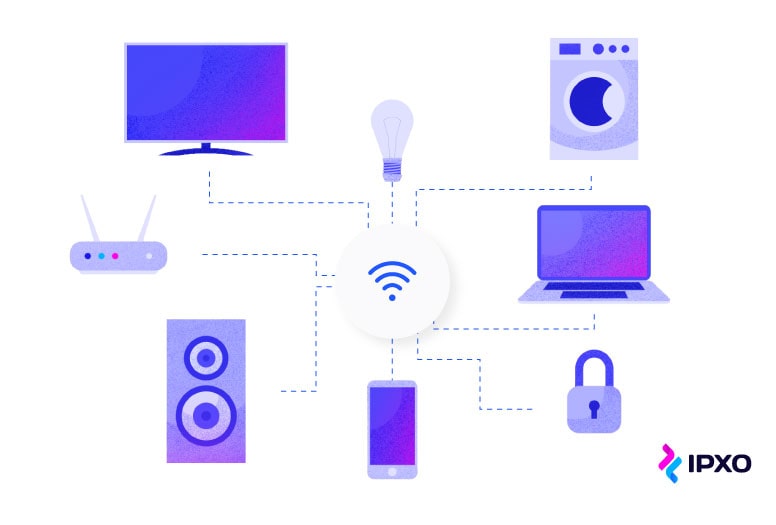
IoT applications
So, which fields specifically can use the IoT? Let’s look at some of the existing or theoretical applications for IoT in business and our everyday lives. Bear in mind, this is not a complete list, as the potential applications are too many to mention all here.
1. Manufacturing
The idea here is that the machines that are part of the manufacturing process can be constantly monitored, with their performance tracked and analyzed continuously. This allows operators to ensure the machines are running efficiently.
Operators are able to anticipate faults, avoid failures and identify the source of quality defects much more effectively. They can also more easily track expensive goods and equipment through the production line.
2. Healthcare
Right now, doctors rely on a list of symptoms, blood tests or expensive scanning technology to identify issues with their patients. Due to this, most healthcare is responsive rather than preventative.
With the help of connected medical devices and implants, it’s possible that the healthcare industry could provide doctors with access to a whole host of data about their patients. What’s more, if health tracking IoT technology is widely adopted, we might be able to identify health issues sooner and, consequently, have better health outcomes.
Healthcare can become more preventative and help people lead happier, healthier lives.
3. Wearables
Here’s where the Internet of Things is likely to make the biggest impact in our everyday lives.
We’ve already seen ventures into the wearable technology space, with gadgets like Google Glass and Fitbit enabling our bodies to either datafy ourselves or the world around us.
As IoT technology becomes smaller and more affordable, we’re likely to see an increasing number of wearable gadgets. They can help monitor our health and activity or make our experience of the world around us more interactive.
4. Smart cities
So far, we’ve talked about the IoT on a small or very specific scale. But one of the most promising applications of the technology is on a much bigger, city-wide scale.
Smart cities are a theoretical way to operate cities, where networks and services become more efficient with the help of the IoT. The idea is that resources within the city could be distributed more logically, improve the quality of life for inhabitants and cut down on emissions.
IoT architects can achieve this by connecting smart devices from within homes, offices, public spaces and other locations to create a digital map of need and use.
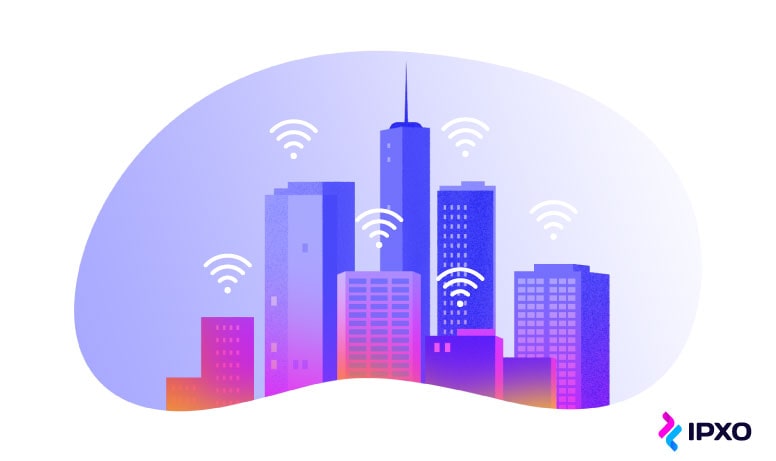
What are the benefits of IoT?
Whether it’s companies, governments, cities or consumers, everyone stands to benefit from the growing adoption of the Internet of Things. While each of the physical devices connected to the Internet of Things solves its own unique problem, there are a number of general benefits all those physical devices offer.
IoT allows people to complete tasks fast
The Internet of Things is all about making less work for humans by tracking and automating all kinds of processes. When machines can share data with each other and act upon that data without human input, different systems can run smoother.
In industrial systems, machines that transfer data to each other can help make supply chains faster and allow manufacturing to operate more efficiently. Imagine a car factory where each piece intended to go into a car is tracked to make sure the right parts are available at the right time.
Then, of course, there’s the everyday time-saving that consumers can expect. Smart home devices like IoT doorbells or kitchen aids can help cut down the time it takes to do things around the house and free up more leisure time.
Simplicity of monitoring data
The accessibility of data is a key aspect of the IoT. Companies may be better equipped to track their stock levels, restock only what and when needed, save money and time.
For consumers, tools like smart thermostats offer the opportunity both to track their energy consumption as well as see peak times of usage. This allows planning heating and cooling cycles around this data for efficiency.
Saving money
Whether it’s helping consumers better manage their household budget, helping the industry monitor the condition of equipment or facilitating smoother supply chains, the IoT may help save billions of dollars.
A smart refrigerator may help you buy only what you really need at the store and reduce food waste. An early warning of imminent hardware failures may help perform proactive repairs. IoT may help organizations to better track inventory and protect against overordering.
IoT also provides companies with improved big data analytics. This means that when they collect data about their customers, they can market their goods and services at a lower price.
Saving resources
The IoT promises a future where the distribution and use of resources are more efficient and where waste is minimal.
IoT offers the opportunity for large-scale infrastructure networks – like those of smart cities – to better allocate resources where they’re the most useful. By creating smoother processes in everyday life, the IoT also ensures that minimal resources suffice in task completion.

Disadvantages of IoT
Alas, not everything associated with the Internet of Things is bright and promising. Realistically, there are going to be some major disadvantages to grapple with as the technology grows.
Unemployment
Enterprise IoT automates business processes. Unfortunately, the adoption of the IoT is likely to lead to an increasing number of redundant functions for people in the workplace.
As IoT devices replace human labor, people could be replaced by machines. Unless new jobs are created for those made redundant by the improved technology, it is likely to cause an unemployment and welfare crisis.
Complex systems
The IoT is likely to make it possible to create more complex systems than we’ve ever seen before. In the future, mechanical and digital machines will run autonomously in ever-increasingly complex and harder-to-understand ways.
Once we remove the human element from these automated processes, what happens when something goes wrong? One small fault in the running of these complex systems could create much bigger problems down the line.
Compatibility
Data portability is another big issue related to the Internet of Things. There are tons of different kinds of IoT-connected devices and purposes. There’s a good chance that, as all these IoT applications evolve in isolation, we’ll get to a point where one IoT platform cannot communicate effectively with another.
Due to this, we must have a conversation about IoT device management and how we want the interrelated computing devices that make up the IoT to communicate with each other.
Technological dependency
Less than 50 years ago, if something went wrong with your car, anyone with basic knowledge in mechanics could work out the problem. Today, our cars are complex systems that combine computers and patented technology.
As a result, we’re increasingly reliant on private companies and experts for tech solutions. The IoT is only going to increase our dependency on technology.
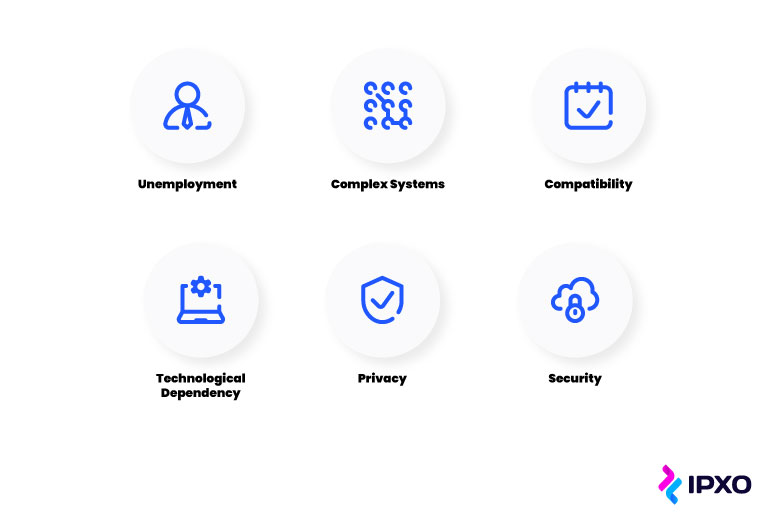
All in all, what arguably is the biggest disadvantage of the IoT is the privacy and security issues. These issues are so significant, they require closer attention.
IoT privacy and security
We are all aware of the discussions around the use of personal data by social media platforms and other companies. If we plan to greatly increase the amount of internet connectivity in our lives, big questions around data privacy and security are bound to come up.
This is the major drawback of the Internet of Things.
In industrial settings, companies should be concerned about hackers accessing a data center and harvesting sensitive information. There’s also the concern that a bug that infects one IoT device could infect other connected devices in its network.
How do we strike a balance between data portability, utility and security? It’s important that, with the adoption of the Internet of Things, we build security systems fit for purpose in the new connected world of connected things.
Conclusion
The Internet of Things is not coming. It’s already here. IoT-based systems are already in use in all kinds of industries, and IoT gadgets are an increasingly common commodity among consumer electronics.
If you use wearable devices like smartwatches, have driven connected cars or used other devices that use wireless networks to improve their functionality, you’ve already interacted with the Internet of Things.
While the technology still needs to address plenty of concerns, most pressingly around data privacy, there’s no question that all the possible IoT deployments make the Internet of Things an exciting prospect.
How will you utilize IoT platforms in your personal and professional life? The possibilities are seemingly endless.
About the author
Table of contents
The history of IoT
IPv6 changes the world of IoT
Why is the internet of things important?
How does IoT work?
IoT devices
IoT applications
1. Manufacturing
2. Healthcare
3. Wearables
4. Smart cities
What are the benefits of IoT?
IoT allows people to complete tasks fast
Simplicity of monitoring data
Saving money
Saving resources
Disadvantages of IoT
Unemployment
Complex systems
Compatibility
Technological dependency
IoT privacy and security
Conclusion
Related reading
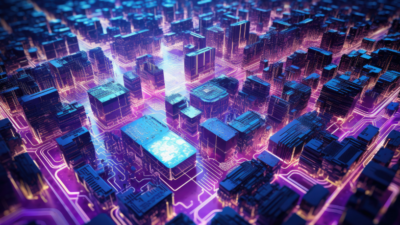
Open Internet and IP Address Management
Embrace the Open Internet's principles and navigate the evolving landscape of IP address management. Discover how we're adapting to new realities at IPXO, empowering you with access to IP…
Read more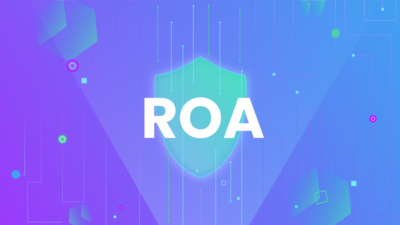
The Evolution of Route Origin Authorization: Insights from IPXO’s Half-Year Journey
Discover the transformative power of Route Origin Authorization and fortify your network's security and efficiency with valuable insights from IPXO's mid-2023 journey.
Read more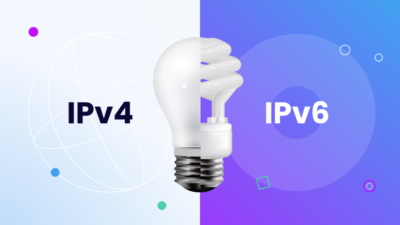
What Is More Energy-Efficient: IPv4 or IPv6?
The transition to IPv6 holds the potential to reduce global energy consumption and foster a sustainable future in networking. However, the slow adoption rates of IPv6 have prompted alternative…
Read moreSubscribe to the IPXO email and don’t miss any news!
